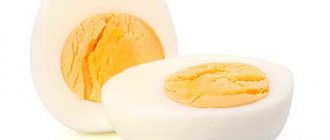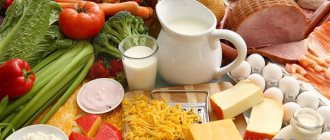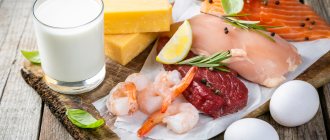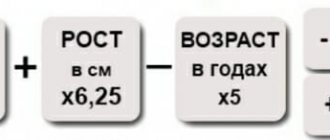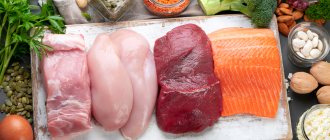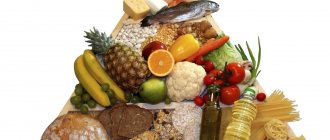This article is about how to count calories correctly and not make mistakes.
By eating by eye, we get results by eye.
Why can't you lose weight or can't gain weight? Do you think you eat like a sparrow when you're trying to lose extra pounds, or like a hungry wolf when you're trying to gain weight? If there is no result from the diet, then your estimate of calorie intake is incorrect. When asked, “How many calories do you get per day?” - you won't have an exact answer.
People tend to underestimate their intake when dieting and overestimate it when they want to gain weight. In this study, people's error in determining their caloric intake on a diet without calorie counting was 50%. Think about it!
Counting calories gives an objective picture of your diet. Yes, it is not 100% accurate, but this is not necessary. At least it is more accurate than by eye, palm, handful or glass.
Counting calories is easy, but there are some nuances. We'll talk about them. How not to make mistakes and take into account the really important details in order to manage your weight as accurately as possible.
It can be difficult at first because you may not be able to correctly count the correct amount of calories in foods right away. The calculation itself at the beginning of the journey will take a lot of time and search, and this can be annoying. After a few weeks of self-monitoring, you will become a pro at estimating the calorie content of foods.
What is needed for counting
People are divided into two types:
- Those who count calories
— And those who don’t count calories.
#1 – You can’t do without a kitchen scale
It is very difficult to judge by eye the weight of, for example, two pieces of meat of approximately the same size. A lean piece will weigh more than a sinewy piece with a bone. The difference can be twofold.
Let's not deceive ourselves or try to guess the weight. The accuracy of the kitchen scale weighing method will be the best way to determine the weight of food.
If you don’t have kitchen scales, you can order them on wildberries, amazon, aliexpress, mvideo, eldorado and other online stores. Read reviews and buy the model you like. This will be a good investment in your own health.
#2 – Calorie counting apps will make your life easier
Of course, you can write everything down in a notebook or constantly look at calorie tables, but apps will make the process easier and more interesting. More on this below.
#3 - Patience
Patience will also come in handy at first. Don't be discouraged if you find it difficult at first or if the counting takes a long time. At first we don’t like any unfamiliar task, then we get involved and begin to find our own thrill in it.
Simple and complex carbohydrates
The easiest classification to understand is simple (fast) and complex (slow) carbohydrates.
The main function of complex carbohydrates is to provide us with a constant level of energy throughout the day. We will feel full for a long time, which means we will snack less and gain extra calories.
If carbohydrates are processed or fast, they immediately cause a jump in blood sugar and affect insulin and its sensitivity. In addition, they feed pathogenic flora.
The glycemic index (abbreviated GI) of a food indicates how the blood sugar level changes when it is consumed. The higher the GI, the faster the increase in sugar occurs.
All products can be divided into several groups
:
- High GI foods
(from 70 and above):
- give a lot of energy;
- They fill you up quickly and are absorbed faster, but at the same time the feeling of hunger sets in faster.
- Products with low
(from 10 to 40)
and average GI
(from 40 to 70) - allow you to control blood sugar levels;
- are absorbed slowly and gradually release the necessary energy.
Now it is clear that foods with a high GI are fast carbohydrates, and foods with a low GI and medium GI are slow carbohydrates.
| Slow carbohydrates | Glycemic index | Fast carbohydrates | Glycemic index |
| Cereals and side dishes | |||
| Durum wheat pasta | 45 | French fries | 95 |
| Brown rice | 45 | Instant White Rice | 90 |
| Oat groats | 40 | Cornflakes | 85 |
| Buckwheat | 40 | Mashed potatoes | 80 |
| Quinoa | 40 | Semolina | 80 |
| Spelled, spelt | 40 | Muesli with sugar and dried fruits | 80 |
| Amaranth | 35 | Millet | 70 |
| Chickpeas | 30 | White rice | 70 |
| Mash | 25 | Soft wheat noodles | 70 |
| Flour | |||
| Coconut flour | 35 | Premium wheat flour | 85 |
| Whole grain wheat flour | 45 | Rice flour | 95 |
| Whole grain spelled or spelled flour | 45 | Corn flour | 70 |
| Snacks | |||
| Whole grain bread | 45 | Butter buns | 95 |
| Dark chocolate (<75% cocoa) | 25 | Milk chocolate | 70 |
| Carob chocolate | 30 | Chocolate bar with nougat and nuts | 70 |
| Coconut chips | 35 | Potato chips | 80 |
| Sugar and sweeteners | |||
| Stevia | 0 | White sugar | 70 |
| Coconut sugar | 35 | Cane brown sugar | 70 |
| Jerusalem artichoke syrup | 15 | Honey | 70 |
| Fruits | |||
| Apple | 30 | Watermelon | 70 |
| Grapefruit | 20 | Banana | 65 |
| Apricot | 20 | A pineapple | 65 |
Why is it important to know the glycemic index of foods? To avoid sudden spikes in blood sugar, high insulin, excess weight, problems with hormonal levels, brain function and the occurrence of low-grade inflammatory processes.
What you need to know
Nutrient Calories
You need to remember that the calorie content of foods consists of the calorie content of the macronutrients that make up them - these are proteins, fats, carbohydrates and fiber.
Table 1. Energy value of food macronutrients
| Amount of energy | |
| 1 g protein | 4 kcal |
| 1 g carbohydrates | 4 kcal |
| 1 g fat | 9 kcal |
| 1 g fiber | 1.5 kcal |
| 1 g alcohol (alcohol) | 7 kcal* |
*Please check the calorie content of a specific alcoholic product, as... it is an alcohol-containing solution.
In fact, these caloric values are average, but these numbers are enough to correctly estimate the energy intake.
Two apples from the same tree may have different caloric content and composition of proteins, fats, and carbohydrates. However, this difference can be neglected. No one will take their food to the laboratory to accurately find out the macro and micronutrient composition of food.
People have long used the method of counting calories for the purpose of gaining weight and losing weight. A large number of studies prove its effectiveness. You can easily count the caloric content of nutrients, as in the table above.
Dry and raw product
In what form should food be weighed - raw or cooked? Dry and cooked foods have the SAME calorie content, but DIFFERENT weight due to the water they contain.
When cooked, cereals take up water, increasing in volume; meat, on the contrary, releases water during heat treatment, decreasing in size.
For example, buckwheat absorbs water when cooked and increases in volume by about 3 times. Add 100 g of buckwheat, boil it and get 300 g.
The calorie content of buckwheat is 330 kcal per 100 g. After cooking, we get three times more product from water, which has zero calorie content. Thus, the calorie content of buckwheat cooked in water will be 110 kcal per 100 g.
Please be aware of this difference. If you boil a whole pan, then when weighing the portion, divide the calorie content by 3 to get the correct numbers.
The situation with meat is the opposite. Take a piece weighing 200 g and fry it in a frying pan. The meat shrinks, getting rid of water, and loses weight by almost 2 times. Let's assume that when baking we got 100 g of the dish.
The calorie content of lean pork is 250 kcal per 100 g. When baked, we will get the same calorie content, but already in 100 g.
Don't count the meat as it's cooked. Your fantasies about not getting enough protein are unfounded. Calculate the raw weight or multiply the weight of the finished product by 2, as in our example.
Don’t be lazy and weigh once the weight of dry cereals and the resulting porridge from it, as well as the weight of raw and cooked meat. Do this for each cooking method (cooking, frying, baking) you use to find out exactly how much the food is reduced or increased. Next, simply multiply or divide the weight of the finished dish by the resulting coefficient.
Another example - dry rice weighing 200 g boiled in water to 440 g (increased 2.2 times). To calculate the KBJU for an 80 g portion of boiled rice, I will divide the KBJU for dry rice by 2.2.
The calorie content of dry white rice is 344 kcal per 100 g. 100 g of boiled rice will contain 344/2.2 = 156 kcal. And in a serving of 80 g there will be 156 x 0.8 = 125 kcal.
Everyone cooks differently. The more water you add to the cereal, the more it will boil. The longer you cook pasta, the more water it absorbs. Therefore, everyone will have their own coefficients.
Nuances when weighing products
When weighing fruit, consider the weight of the peel. For example, in bananas it makes up a significant part - a third of the fruit; in pomegranate, the seeds and peel weigh more than half of the total mass. Fruits such as apples can be counted whole. The seeds and peel make up less than 10% of the fruit's weight.
We weigh chicken without bones, cottage cheese without packaging, eggs without shells, oranges without peel, etc.
With experience, you will understand what to consider and what not to consider.
About the system error
Even with a permanent error, such as not accounting for the raw/cooked meal difference, calorie counting will still work . If your weight does not change, you will simply adjust your caloric intake.
For example:
I want to gain more and I don’t know that when rice is cooked, it takes in water and swells 2.5 times. I eat a 120 g portion of rice every day, I count calories and BJU, as for rice weighing 120 g. But my weight does not change, and I think that I am overloading on carbohydrates.
In the example above, we already calculated the calorie content of dry white rice. It is equal to 344 kcal per 100 g. According to my calculations, I consumed 344 x 1.2 = 412 kcal.
In fact, I don’t have enough calories, because in reality I eat a portion not of 120 g of rice, but of 48 g of dry product and get 2.5 times less calories and nutritional value from such a portion.
412/2.5 = 165 kcal
I didn’t get 412 – 165 = 247 kcal because I didn’t take into account the change in calorie content when cooking rice.
But even if I don’t know about these features, but I know that I have to eat more than I spend in a day in order to gain weight, I will start eating more. Your calorie intake will increase and your weight will move off.
If you don't take something into account when counting calories, but know what energy balance , the method will still work.
The energy balance equation is the basis for changes in body weight. If we receive more energy from food than we spend per day, we increase our reserves (our weight). If there is not enough energy to cover expenses, reserves will be spent (weight will decrease)
How to count KBJU for weight loss or weight gain
To lose weight, a calorie deficit is created: the daily norm of KBZHU is reduced by 10-20%, depending on the amount of extra pounds.
It is dangerous to create a deficit above 20% even with a lot of excess weight; this is fraught with serious health problems.
One of the BJU percentage schemes recommended by experts for weight loss is: 40 / 35 / 25.
- Let's consider the norm of KBZHU using the example of a woman who wants to lose weight, who is still 32 years old, height 158 cm, but her weight is already 65 kg, she trains 3 times a week:
Using the above formula, we calculate the daily calorie intake: 1922 kcal.
Subtract 10-20%.
To lose weight without harm to health, our heroine should maintain calorie content in the range of 1538-1730 kcal.
Of them:
- protein (40%) = 615-692 kcal = 154-173 g;
- fat (35%) = 538-605 kcal = 59-67 g;
- carbohydrates (25%) = 385-433 kcal = 96-108 g.
To gain muscle mass, the daily calorie intake needs to be increased by 10-20%.
The percentage of BJU recommended by experts for weight loss: 30 / 25 / 45.
- The KBZH norm for a 30-year-old man with a height of 172 cm and a weight of 60 kg, who goes to the gym 4 times a week in order to build muscle:
Daily calorie intake: 2398 kcal.
Add 10-20%.
To achieve the goal, a man must consume from 2638 to 2878 kcal every day.
Of them:
- protein (30%) = 791-863 kcal = 198-215 g;
- fat (25%) = 660-720 kcal = 73-80 g;
- carbohydrates (45%) = 1187-1295 kcal = 297-324 g.
Don’t forget, recalculation of the KBZHU norm must be done every ±5 kg. Then the transition to a new nutritional system will be as smooth and painless as possible for the body.
Arguments of opponents of calorie counting
The stated calorie content on the labels does not correspond to reality.
Because of this, it is argued that it is impossible to accurately determine how many kcal we consume.
Food manufacturers indicate the average calorie content of their products on packages, so there is an error. In restaurants, the chef doesn't care about your figure. The caloric content of the dishes is indicated approximately.
There is a decree of the Government of the Russian Federation dated August 15, 1997 N 1036 on the provision of reliable information on the nutritional value of public catering products (link to document). This resolution obliges providers in the field of catering services to provide accurate information about calorie content, dietary supplements, vitamins and minerals in their products.
In fast food restaurants KFC, Burger King, Subway and McDonald's, information about the calorie content of menu items can be found on their website.
Despite all these inaccuracies, you can safely take information about the calorie content of products from the labels; we still have no other choice) Even if some product is constantly present in your diet and because of it you cannot lose weight, because the manufacturer has underestimated the calorie content , you can simply create a larger daily caloric deficit or increase your calorie expenditure by increasing your activity.
Not all calories are absorbed
The degree of digestion of foods affects the number of calories received.
A healthy person learns:
- Animal protein is approximately 90-95%, vegetable protein is 80-85%.
- Fats at 95-97%.
- Food rich in carbohydrates is 80-95%, depending on its fiber content.
I believe that there is no need to worry about these values. What is important to us is not exact numbers, but the relationship between the calories we count and the dynamics of weight change. If we are missing something, we can make adjustments to the overall caloric intake.
I will even say more - we all digest foods differently. But this should not worry us. Everyone counts their calories and they WILL work for your weight loss or weight gain. Did you miss something when losing weight? Never mind, just cut off another 10% of calories and continue to ignore some factor.
Despite all the errors, these figures are enough to create a diet for weight loss or weight gain.
Calculation of daily nutritional intake
The daily nutritional intake should be determined individually for each person. This indicator depends on:
- growth;
- age;
- weight;
- gender identity;
- level of physical activity.
The intensity of weight loss is also taken into account - the faster you need to get results, the lower the energy value of the food consumed should be. However, regular malnutrition and intense weight loss are fraught with negative consequences for the body. Therefore, in order to correctly calculate the amount of food consumed, it is recommended to use a calorie calculator for weight loss and a body mass index calculator.
Errors when counting calories
We don’t take into account everything that goes into the mouth or about “invisible” calories
We count everything, absolutely everything we put into our mouths, except water.
If you finish eating after your younger brother or child, consider the calories. Fry meat in oil - consider the calorie content of the oil. If you add healthy olive oil to your salad, don’t forget about the 900 kcal contained in 100 g of this oil.
Even 100 kcal not taken into account per day will result in 3000 kcal on top in a month. This is the answer to why we gain excess weight if we don't control what we eat.
Watch Boris Tsatsouline’s video about how we are mistaken about the size of food portions and determining their calorie content:
Harmless fruit drinks and homemade compotes can provide an additional 200-300 kcal per day.
Do you drink tea with sugar? Sugar has a calorie content of 398 kcal per 100 g, 32 kcal in a teaspoon. Don't forget to take this into account! 3-4 mugs of tea with sugar per day will give 120 kcal on top.
Do you drink cappuccino? 2/3 of the drink is milk, with a calorie content of 64 kcal per 100 ml. So, one 150 ml serving contains 100 ml of milk. 3 glasses of coffee per day will provide 190 additional kcal.
These are the same “invisible” calories)))
Of course, vegetables such as spinach, cabbage, peppers, tomatoes and zucchini are so low in calories that there is usually no point in counting them at all. It is almost impossible to create a calorie surplus by overeating, say, spinach. These are all non-starchy foods.
At first, I recommend counting everything except water, mainly to estimate the calorie content of the foods you eat on a regular basis. Next, you can ignore non-starchy foods.
Due to fiber and water, vegetables fill us up very well. But don’t forget about what you use them with, say, butter, mayonnaise, sauces, etc. - these things need to be counted!
We count starchy vegetables and fruits. These are potatoes, beets, bananas, watermelon (this is a berry), grapes.
Starchy and non-starchy carbohydrates
There is another category of invisible calories - these are super healthy foods such as fish oil, olive, flaxseed and other oils. If you gain the norm of Omega-3, 6 fatty acids by eating a tablespoon of healthy oil in the morning, you get 135 kcal per 15 ml. For weight loss, this is critical if you are on the borderline caloric value.
We use standard recipes from apps
Everyone cooks differently. Your soup may be different from what a popular fitness blogger made. Your recipe may contain more or less calories. However, even here everything may not be so bad. If you eat the dish constantly, then the error will be visible in the absence of a weight change result. Adjust your calories and move on.
Still, it is better when you are preparing some complex dish consisting of several ingredients, for example, soup, cake, casserole, pizza, not to look for its calorie content in applications or tables. Before cooking, weigh each ingredient, calculate their energy value and BJU, and add up the resulting numbers. The result will be more accurate.
Let's calculate the calorie content of homemade Olivier, as the guys from Lifehacker did (https://lifehacker.ru/podschyot-kalorij). Take 300 g of boiled potatoes and doctor's sausage, 120 g of mayonnaise, 200 g of canned green peas, 150 g of pickles and 275 g of boiled eggs.
The mass of the dish is 1345 g; the rest of the numbers on the plate are:
| Ingredient | Quantity, g | Energy value, kcal | Proteins, g | Fats, g | Carbohydrates, g |
| Boiled potatoes | 300 | 246 | 6 | 1,2 | 50,1 |
| Doctor's sausage | 300 | 771 | 78,4 | 66,6 | 4,5 |
| Mayonnaise | 120 | 748 | 3,72 | 80,4 | 3,1 |
| Green pea | 200 | 104 | 9,6 | 0,4 | 15 |
| Salted cucumbers | 150 | 16,5 | 1,2 | 0,15 | 2,55 |
| Eggs | 275 | 431,7 | 34,9 | 30 | 1,92 |
| Total: | 1345 | 2318 | 93,8 | 178,7 | 77,19 |
You can enter a dish into a calorie counting app and then simply enter the serving size. The application itself will show the KBJU. It's free and easy.
You can count calories and nutritional supplements in a notebook, but apps save your time and make your life easier.
Calorie content of rolls
Today, Japanese cuisine is considered very popular. And it’s quite understandable why. Our compatriots love not only tasty, but also beautiful food.
And rolls and sushi are created with this in mind. A piece of cucumber, cream cheese and salmon, all wrapped in rice and nori, and beautifully laid out on a plate - what could be more pleasant and beautiful? Many people ask - what is the calorie content of rolls and sushi? This question can be answered this way - it all depends on what kind of dish you choose.
Philadelphia with cream cheese is not at all a diet food, but an avocado roll will help suppress hunger, but at the same time will not harm your figure. The same principle applies to the calorie content of sushi. On average, 1 piece contains about 40-60 kcal. But there are exceptions to the rules. The same dishes with cheese are significantly superior in calories to simple sushi with vegetables or flying fish caviar. As a rule, many restaurants indicate the energy value of dishes in their menu, which helps visitors decide what they will eat for breakfast, lunch or dinner.
Applications and programs for counting calories
I will focus on the two most popular ones - MyFitnessPal and Fatsecret. They are in Russian, you can download them for free using the links below.
MyFitnessPal is a great app. Don't be afraid to poke around and check everything. It has a lot of useful functions and interesting things.
Visual macro in the MyFitnessPal application
To track the dynamics of results, MyFitnessPal has weight and girth indicators. For greater clarity, you can make photo reports and indicate your weight in the photo. The graph displays the dynamics when you enter data into the application for at least a week
Macro in Fatsecret
Fatsecret also shows visual dynamics of weight changes in the form of a graph
During registration, any application will ask you to enter your data - height, weight, activity level and goals (weight gain, weight loss or maintenance) and calculate your daily calorie intake. The numbers will be approximate. How to calculate all the necessary calories for weight loss most accurately, I tell you in detail in my article on losing weight.
The programs will replace your food diary in a notebook (although you can keep one) and calorie tables, save time and make the counting process visual and interesting. Graphs and tablets will delight people who love to count and analyze everything.
When choosing food you can:
- Use ready-made dishes entered into the database by other users;
- Enter foods and dishes that you eat frequently manually once and then enter only the serving size. This is necessary for greater accuracy. You don’t take dishes that are in the database and are similar to your calorie content and nutritional value, you enter exact values;
- Create a new dish;
- Use a barcode scanner, and if the product is in the database, the application will display all the information about it. If a product is not in the database, it is easy to add it by indicating KBJU.
When adding a dish to MyFitnessPal, the serving size is selected based on 100g, but you can simply enter the weight of the dish. Everything is very flexible.
With applications, “sports interest” appears. Your transformation process can be visible to other users if you so choose. You can see what kind of diet your friend has and how many calories he consumes. This is great and interesting!
Ratio of proteins, fats and carbohydrates
The body needs three main groups of nutrients to function normally: proteins, fats and carbohydrates, also called macronutrients. At the same time, in order for the metabolism not to slow down, proteins, fats and carbohydrates must enter the body in certain proportions. Before calculating BZHU, it is necessary to calculate the calorie content of the diet.
Calorie content
- this is the amount of energy that the body receives as a result of food processing. Knowing the total number of calories affects the result of the efforts of a person who is pursuing a specific goal: losing weight, gaining weight, keeping fit.
If a person needs to lose weight, he needs to reduce the caloric content of food, for example, by 300 or 500 calories, depending on weight.
After this, you need to calculate the BZHU ratio.
Let's look at an example
:
The girl wants to lose weight. She consumes 1,700 calories, so we introduce a deficit of 300 kcal. Now the calorie content of her diet is 1,400 kcal, which must be divided into BZHU:
- Proteins should account for 40-50% of the total calorie content;
- for carbohydrates - 30%;
- for fats - 20-25%.
If a girl is gaining weight, it is necessary to create a calorie surplus - maintain the diet by 1,700 kcal or add 100 calories. The body easily obtains energy from carbohydrates and gains weight. Therefore, the BJU ratio will be different:
- proteins - 30%;
- fats - 20-25%;
- carbohydrates - 50-60%.
We recommend
“Rational nutrition: principles and features” Read more
If a person needs to maintain balance, but at the same time gain relief, the BZHU ratio will be as follows:
- proteins - 40%;
- fats - 20-25%;
- carbohydrates - 40%.
As you have already noticed, the amount of fat never changes.
When making an individual calculation, the following are taken into account: age, gender, height, weight, level of physical activity.
We recommend using special calorie calculators. For example: https://caloriecontrol.org/healthy-weight-toolkit/assessment-calculator/
How to distribute the calculated calories throughout the day?
An example of a diet for 1600 kcal per day. We will distribute them into 3 main meals and 1 additional meal.
Breakfast: 400 kcal (25%).
Lunch: 560 kcal (35%).
Snack (Five o'clock): 160 kcal (10%).
Dinner: 400 kcal (25%).
How to count calories without scales
If you don’t have a kitchen scale for one reason or another, you can count calories using your hands.
Whites = palm
Choose high-protein foods such as meat, fish, eggs and dairy products, beans. Your palm will be a measure of the protein portion per meal (list of foods rich in proteins).
One serving of protein for men
One serving of protein for women
Fat = thumb
Make a diet of high-quality fats of plant and animal origin, for example, vegetable oils, nut butters, nuts, avocados, lard (more about healthy fats). Thumb is a measure of one serving of fat per meal.
Single portion of fat for men
Single serving of fat for women
Carbohydrates = handful
Cup your palms and get one serving of carbohydrates. Carbohydrate foods can be different, but it is important that they satiate you well, for example, fruits, grains and cereal products, buckwheat (read more about carbohydrate foods on a diet).
One serving of carbohydrates for men
One serving of carbohydrates for women
Vegetables = fist
The size of your fist will be the serving of vegetables in your meal. Choose non-starchy vegetables such as tomatoes, cucumbers, greens, lettuce, broccoli, spinach, carrots, cabbage.
One serving of vegetables for men
Single serving of vegetables for women
The above photos show one meal for men and women. For both sexes, 4 such meals per day are needed to maintain weight. To lose weight, remove one finger of fat or one palm of carbohydrates from any food.
This form of meal planning is a starting point, just like counting calories on a scale. Stay flexible and adjust your portions based on your hunger and your weight loss results.
Advantages of the method
This technique allows you to establish a healthy diet without stress for the body and abandon significant restrictions, due to which “breakdowns” most often occur. When you put your body on a strict diet, you create unbearable conditions for it. As a result, it begins to create additional fat reserves, and your weight increases.
Knowing how to correctly count calories and use this information in practice, you can create a complete, healthy diet. This method of losing weight brings benefits to the body, which cannot be said about hunger strikes and various mono-diets.
Your favorite foods will continue to remain on the menu, and you just need to maintain your calorie limits. In order not to go beyond the norm, you will begin to gradually give up eating harmful foods and replace them with healthier ones. At the same time, you can enjoy your favorite treat whenever you want.
Gradually you will learn to plan your diet and fill it with the right foods. You will begin to monitor your own nutrition and take a more thoughtful approach to purchasing groceries.
Constantly counting calories for weight loss will ensure that your body gets enough nutrients: fats, proteins and carbohydrates. Such weight loss will be safe and uniform, thanks to which the final result will exceed your expectations. By controlling your diet, you can avoid many negative aspects. For example, against the background of a lack of fat, problems with the hormonal system progress, and a deficiency of carbohydrates leads to a loss of strength and energy. Many diets are built on maintaining an excess of proteins, but this is also wrong, since it can give impetus to the development of kidney and gastrointestinal diseases.
Calorie-based meal planning
Calculation of daily calorie content for a moderately hypocaloric diet (formula adopted and approved by WHO)
1. Calculation of basal metabolic rate:
Women
18-30 years: 0.0621*real body weight in kg +2.0357
31-60 years: 0.0342*real body weight in kg +3.5377
over 60 years: 0.0491*real body weight in kg +2.4587
The result obtained is multiplied by 240 (conversion from mJ to kcal)
2. Calculation of total energy expenditure adjusted for physical activity:
Baud rate 1.1 is low
1.3 moderate
1.5 high
3. Calculation of the hypocaloric daily diet:
Subtract 500-600 kcal from the figure obtained in formula No. 2.
By counting calories, you take care of your own body. If, in addition to proper nutrition, you practice sports and maintain muscle mass, then your figure will become more toned. Proper nutrition prevents unwanted muscle loss. The result of losing weight will be more effective and lasting.
2-3 months of regular calorie counting are enough to adjust your eating habits and gain an understanding of what your ideal lunch should look like. Gradually, you will remember approximately what calorie content a particular product has, and you will make combinations without doing calculations on paper. All information will already be stored in memory.
Now “gluttonous days” will not be able to destroy your figure. To compensate for such a “breakdown”, you will only need to do an energy-intensive workout or reduce your calorie intake for a couple of days. Gradually, you will learn to maintain the achieved physical shape without grueling weight loss. Maintain a slight calorie deficit to stay in great shape.
Keep life easy
Please don't become obsessed with counting calories. It's just a way to control nutrition. If you can’t weigh something, buy the product already weighed and with information on the label about KZHBU. If you can’t count something, for example, at a barbecue picnic or a party with friends, eat by eye.
The main thing is not to create a cult of life out of calorie counting. Calorie counting needs to serve for a happy life and be conveniently integrated into your lifestyle.
Over time, you can stop counting calories, because you will become a mega-professional in assessing your diet and will be able to stay on the maintenance calorie level by eye)))
Download the calorie table and start losing weight right now!
We have collected on this page calorie tables for the most popular dishes and products: rolls, sushi, soups, meat, fish, cheeses and desserts, and much more. Download, save in your phone, or print, and use it for your health! For reference: if you want to lose weight, try to limit the number of kcal to 1200. On average, a girl or woman leading an inactive lifestyle burns 1500 kcal per day. Therefore, just try a little, give up buns and cakes, and you will immediately see a wonderful result!
- Table of calorie content of foods.
- The best motivation for losing weight!.
- Weight loss with glycemic index.
- The Dukan diet will help everyone lose weight!
- Super diet! Up to -30 kg per month!.
- How Jasmine lost 20 kg.
- The Atkins diet is heaven for meat lovers!
What is energy value, calorie content, calories?
Scottish chemist and physicist Joseph Black was the first to derive the concept and is the founder of calorimetry. He was the first scientist to notice the difference between heat and temperature.
Calorimetry-
From the Latin words calor (heat) and metro (to measure) is a set of methods for measuring the amount of heat released or absorbed during various physical or chemical processes.
Calorie content (energy value) -
This is the amount of energy released in the human body from food during the digestion process, provided that it is completely absorbed.
Energy value is measured in kilocalories (kcal) or kilojoules (kJ) per 100 grams of product.
When indicating the calorie content of a product, the prefix “kilo” is often omitted. Simply because, in other words, they are called “food calories.” So, to answer the question: what is the difference between calories and kilocalories? The correct answer is: nothing




